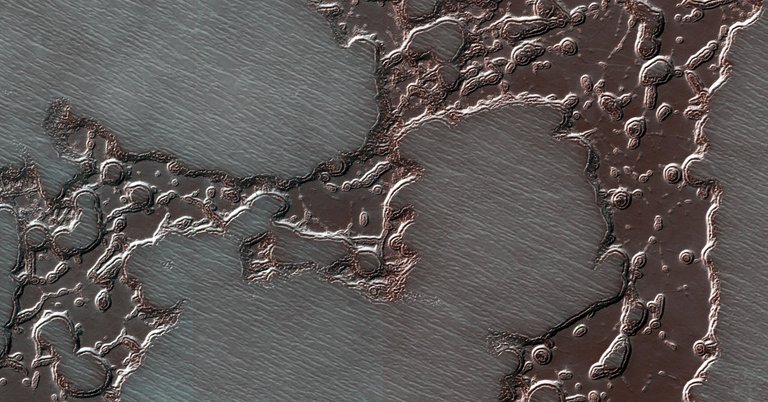
This odd zigzagging terrain is part of Mars’s south pole. These odd features are a result of the Martian seasonal changes. As the water ice that forms in the winter thaws, dry ice underneath it evaporates, leaving these irregular shapes. By observing the seasonal changes on Mars with the HiRise camera on board the Mars Reconnaissance Orbiter, scientists can piece together the bigger climate picture for our dusty planetary neighbor.
After journeying to the south pole, we now find ourselves at the north pole during springtime. This synaptic pattern is caused by the slow thawing of carbon dioxide ice on the surface. As the planet warms in spring, the ice evaporates, leaving behind this elaborate polygon pattern. The bluish patches here are carbon dioxide snow. This photo was taken by the HiRise camera in 2008, when NASA was trying to determine where to place its Phoenix lander.
This special photo is a first for all of space exploration. This is Mars as seen by one of the MarCO CubeSats that traveled alongside InSight on its way to Mars. The two CubeSats and InSight launched from Earth on an Atlas V rocket. Once they were far enough away, the rocket released the trio, and they traveled together to Mars. This wide-angle view shows Mars huge in the background while the high-gain antenna is seen to the right of the frame. When MarCO-B took this photo, it had just completed its primary mission: The pair of mini satellites relayed real-time data back to Earth during the “7 minutes of terror,” which is when InSight plunged through the Mars atmosphere and down to the surface.
This colorful cloud is called the Rosetta Nebula, and it’s what’s known as an emission nebula. As gas and dust collide, new stars are created, and the force of these stellar births pushes the surrounding gas and dust away. During that process, it begins to glow as a result of radiation from the stars’ formation. This image was captured by the European Southern Observatory’s Very Large Telescope in Chile.
Meet Apep—a binary star system that has never been imaged before. The photo, taken by the European Southern Observatory’s Very Large Telescope, shows a pair of stars orbiting each other. Their interaction causes huge stellar winds that push gas and dust around their dance, leaving behind this swirling dust cloud.
Abel 1033 is boldly going where no galaxy cluster has gone before. It is shaped like the USS Enterprise from Star Trek, but sadly it is not a secret gas spaceship but an odd remnant left behind from a collision of two galaxy clusters. Galaxy clusters are the largest known objects in the universe—they can contain thousands of galaxies each and are all bound together by gravity. However, the gas that exists around them can have as much as six times the mass of all the galaxies combined, and that gas is hard to see in only visible light. By combining data from the Chandra X-Ray Observatory, seen here in the purples, and radio observations seen in the blue, the full shape created by the interaction becomes visible.
Welcome to Mars, InSight! This image of Mars, captured by the European Space Agency’s Mars Express Orbiter, shows a region called Elysium Planitia, which is where InSight just landed. (It’s sort of between the black dot at the lower right and the raised candy cane at 3 o’clock.) The lander will operate there for two years while it studies the interior of the planet, searching for marsquakes and studying the heat from below the surface. The area where InSight has set up shop is away from hills and volcano remnants, and that’s a good thing, because InSight needed a very flat and “boring” place to live on Mars. And now Insight has a friendly (sort of) neighbor—it's only a few hundred miles north of where the Curiosity rover is roaming around.
Link to Original Article: https://hackhex.com/science/space-photos-of-the-week-packing-for-mars-1078.html
Source
Plagiarism is the copying & pasting of others work without giving credit to the original author or artist. Plagiarized posts are considered spam.
Spam is discouraged by the community, and may result in action from the cheetah bot.
More information and tips on sharing content.
If you believe this comment is in error, please contact us in #disputes on Discord
Hi! I am a robot. I just upvoted you! I found similar content that readers might be interested in:
https://www.wired.com/story/space-photos-of-the-week-insight-rover/